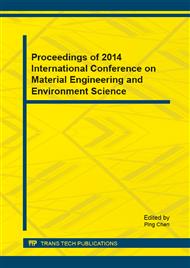[1]
Li, S.P., et al., Production of Lightweight Ceramsite from the Yellow River Silt and its Performance Investigation in a Biological Aerated Filer (BAF) Reactor. Advanced Materials Research, 2013. 699: pp.829-834.
DOI: 10.4028/www.scientific.net/amr.699.829
Google Scholar
[2]
Biswas, K., M.W. Taylor and S.J. Turner, Successional development of biofilms in moving bed biofilm reactor (MBBR) systems treating municipal wastewater. Applied microbiology and biotechnology, 2013: pp.1-12.
DOI: 10.1007/s00253-013-5082-8
Google Scholar
[3]
Nicolella, C., M. Van Loosdrecht and J.J. Heijnen, Wastewater treatment with particulate biofilm reactors. Journal of Biotechnology, 2000. 80(1): pp.1-33.
DOI: 10.1016/s0168-1656(00)00229-7
Google Scholar
[4]
Loukidou, M.X. and A.I. Zouboulis, Comparison of two biological treatment processes using attached-growth biomass for sanitary landfill leachate treatment. Environmental pollution, 2001. 111(2): pp.273-281.
DOI: 10.1016/s0269-7491(00)00069-5
Google Scholar
[5]
Han, W., et al., Application and advantages of novel clay ceramic particles (CCPs) in an up-flow anaerobic bio-filter (UAF) for wastewater treatment. Bioresource technology, (2013).
DOI: 10.1016/j.biortech.2013.03.124
Google Scholar
[6]
Zhao, Y., et al., Research on sludge-fly ash ceramic particles (SFCP) for synthetic and municipal wastewater treatment in biological aerated filter (BAF). Bioresource technology, 2009. 100(21): pp.4955-4962.
DOI: 10.1016/j.biortech.2009.05.025
Google Scholar
[7]
Zhu, S., et al., Effect of magnetic field on the accumulation of polyhydroxyalkanoates (PHAs) by microorganism in activated sludge. Bioprocess and biosystems engineering, 2012. 35(6): pp.985-991.
DOI: 10.1007/s00449-012-0683-7
Google Scholar
[8]
Tomska, A. and L. Wolny, Enhancement of biological wastewater treatment by magnetic field exposure. Desalination, 2008. 222(1): pp.368-373.
DOI: 10.1016/j.desal.2007.01.144
Google Scholar
[9]
Ji, Y., et al., Enhancement of biological treatment of wastewater by magnetic field. Bioresource technology, 2010. 101(22): pp.8535-8540.
DOI: 10.1016/j.biortech.2010.05.094
Google Scholar
[10]
Łebkowska, M., et al., Effect of a static magnetic field on formaldehyde biodegradation in wastewater by activated sludge. Bioresource technology, 2011. 102(19): pp.8777-8782.
DOI: 10.1016/j.biortech.2011.07.040
Google Scholar
[11]
Songlin Dai, Xiaohong Luo, Huanyan Huang, Yaoming Deng, et al. Environmental Pollution and Control. 2009, 31(5): 51-53. In Chinese.
Google Scholar
[12]
Potenza, L., et al., Effects of a static magnetic field on cell growth and gene expression in Escherichia coli. Mutation Research/Genetic Toxicology and Environmental Mutagenesis, 2004. 561(1): pp.53-62.
DOI: 10.1016/j.mrgentox.2004.03.009
Google Scholar
[13]
Su, H.D. and D. Fu, The Experimental of Preparation of Slow-Release Trace Ni2+ Ceramsite and Study about Influence of Wastewater Anaerobic Treatment. Advanced Materials Research, 2012. 454: pp.348-351.
DOI: 10.4028/www.scientific.net/amr.454.348
Google Scholar
[14]
Hartman, M., et al., Thermal Decomposition of Sodium Hydrogen Carbonate and Textural Features of Its Calcines. Industrial & Engineering Chemistry Research, (2013).
DOI: 10.1021/ie400896c
Google Scholar


